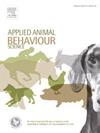Cool, cooperative and competitive – Can we breed for a temperament that promotes performance in Standardbred trotters?
IF 2.2
2区 农林科学
Q1 AGRICULTURE, DAIRY & ANIMAL SCIENCE
引用次数: 0
Abstract
Physical and mental ability to compete is needed for trotters to be successful in harness racing. The ability to cope with a competition atmosphere and an elite training environment also influences the horses’ welfare, career longevity, as well as the safety of the humans handling them. Standardbred trotters have long been bred to be well suited for the sport, but there is still temperament variation in the population. Therefore, the aim of this study was to investigate if there is an interrelationship between temperament traits and trotting performance in Standardbred trotters. Temperament traits in competition situations were assessed for Standardbred trotters through a survey aimed at Swedish and Norwegian trainers from 2019 to 2021. The trainers were asked to rate how often the horses expressed different temperament traits on a linear 7-point scale. A total of 12 temperament traits were included in a factor analysis. Thereafter, factor scores for the three formed factors F_Anxiousness, F_Agreeableness, and F_Excitability, were calculated and further analyzed for a total of 366 horses from 120 trainers. Seven generations of pedigree data as well as routinely recorded performance traits for more than 30 thousand horses were added, and (co)variance components were estimated in bivariate linear animal models. Low to moderate heritability estimates were found for all temperament and performance traits, ranging from 0.13 for F_Anxiousness to 0.50 for F_Excitability. F_Agreeableness was found to be positively correlated with all performance traits, except for with Best racing time for which lower values are desired. The opposite pattern was seen for F_Anxiousness that was negatively correlated with all performance traits, except for Best racing time. A similar, but less strong, tendency was seen for F_Excitability. The correlations between factors for temperament and performance traits showed a consistent pattern, in spite of high standard errors especially for the genetic correlations. The results indicate a genetic variation in temperament traits, and favorable associations between temperament and performance in Standardbred trotters. These promising findings need to be confirmed in a larger dataset with temperament trait observations but point out the possibility to breed for agreeableness and improved performance in trotters without increased anxiousness. In other words, it seems possible to breed cool, cooperative and competitive horses to improve welfare and performance in trotters.
求助全文
约1分钟内获得全文
求助全文
来源期刊

Applied Animal Behaviour Science
农林科学-行为科学
CiteScore
4.40
自引率
21.70%
发文量
191
审稿时长
18.1 weeks
期刊介绍:
This journal publishes relevant information on the behaviour of domesticated and utilized animals.
Topics covered include:
-Behaviour of farm, zoo and laboratory animals in relation to animal management and welfare
-Behaviour of companion animals in relation to behavioural problems, for example, in relation to the training of dogs for different purposes, in relation to behavioural problems
-Studies of the behaviour of wild animals when these studies are relevant from an applied perspective, for example in relation to wildlife management, pest management or nature conservation
-Methodological studies within relevant fields
The principal subjects are farm, companion and laboratory animals, including, of course, poultry. The journal also deals with the following animal subjects:
-Those involved in any farming system, e.g. deer, rabbits and fur-bearing animals
-Those in ANY form of confinement, e.g. zoos, safari parks and other forms of display
-Feral animals, and any animal species which impinge on farming operations, e.g. as causes of loss or damage
-Species used for hunting, recreation etc. may also be considered as acceptable subjects in some instances
-Laboratory animals, if the material relates to their behavioural requirements
 求助内容:
求助内容: 应助结果提醒方式:
应助结果提醒方式:


